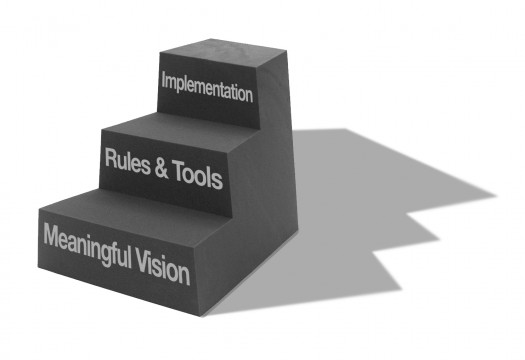A Placemaking Journal
Municipal Placemaking Mistakes 02: Context and sequencing FAIL

My first post in this series explored quantity vs. quality and how cities routinely throw their favor in the wrong direction. Today we consider big picture thinking and how the steps you take in the course of your efforts are not the end, but the means.
Mistake #2: Failure to understand the proper context and sequencing of the three steps of placemaking.
It’s not uncommon that communities, or individuals within them, have growth and development ambitions that could be characterized as placemaking. These are a crucial part of municipal stewardship but it’s important to realize that placemaking, in and of itself, is not an end goal. It’s a contributing factor towards larger ambitions.
It’s not the big picture. It’s a piece of the big picture.
The typical problem involves a community that is focused on generating a specific placemaking tool such as a form-based code. The advocates in the community (who are often well-versed in placemaking issues) try to convince key decision-makers of the code’s importance without providing the context for where it fits into larger municipal goals — chief among them, economic development.
Indeed, the advocates usually want to jump to a discussion of the code’s detailed elements. They talk of the hammer and not the house.
The result is that decision-makers come to view such efforts, in this case a form-based code, in the same light. A destination, where the end result is just a new way of regulating things, as opposed to a key component in leveraging place as, to cite my earlier example, an economic development tool. Or a tool towards better health. Or stronger community ties. Or environmental performance.
The better approach is to provide an understanding of why place matters. How it can help a city get where it’s trying to go. With that shared understanding, you’re then free to approach the prospect of placemaking not as a process of arbitrary initiatives but through its proper sequencing. Three simple, yet critical, steps:
- craft a meaningful vision;
- code or develop regulations (the rules and tools) to achieve that vision; and
- implement purposefully.

We’ll discuss the specifics of each step in greater detail in subsequent articles. For now, I leave you with this: Before launching efforts to create a better place, understand where such efforts plug in. Identify how placemaking can help you — and city leaders — reach larger municipal goals, then help key decision-makers see what you can see. With their support, you’ll be free to embark on a comprehensive and meaningful effort. And proceed in the right order.
–Nathan Norris
Series Overview: Through a series of periodic posts, Nathan Norris will explore how cities hinder their own placemaking efforts, wasting time and money by investing in tools, policies and programs that deliver lousy results. In the process, we’ll be looking to you to help flesh out the content through examples, personal experiences and links to additional resources. The goal? A one-stop, crowdsourced primer for cities and towns seeking advantage in an ever-competitive world.
To view the entire series to date, click here.
If PlaceShakers is our soapbox, our Facebook page is where we step down, grab a drink and enjoy a little conversation. Looking for a heads-up on the latest community-building news and perspective from around the web? Click through and “Like” us and we’ll keep you in the loop.






